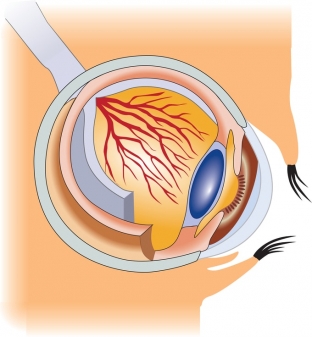Few people know about this disease, it is confused with cataracts of the eye, or with other diseases, since the symptoms resemble disorders of the nervous system, hypertension. Glaucoma is an eye disease that can be congenital or acquired. Due to increased eye pressure, fluid accumulates and optic nerve atrophy occurs. Glaucoma is a chronic type of disease, it cannot be cured, it is only possible to maintain the condition by controlling pressure. In order to preserve the field of view, it is necessary to use complex methods of glaucoma treatment.
Causes and symptoms of glaucoma
The real causes of glaucoma are still unknown to doctors, but there are a number of diseases that are at risk and can lead to the development of this disease. Nerve atrophy begins due to the lack of fluid circulation inside the eye, so intraocular pressure rises. Often glaucoma can develop in the process of age-related changes in the eye, so people get sick (women more than men) after 40 years. The presence of diseases such as diabetes mellitus, myopic refraction or myopia, hypotension, disruption of the endocrine system trigger the development of glaucoma. Congenital glaucoma develops in a child in the womb, when the formation of the visual system of the fetus occurs (after 7 months of pregnancy). It may appear after birth or after a few years. Secondary glaucoma (manifested as a complication) develops after an inflammatory process in the eye, dislocation of the lens, cataracts, during degenerative processes in the eye (iris atrophy), burns, eye injuries, burns, as a result of surgical intervention in the work of the eye. Glaucoma in most manifestations passes without symptoms, so the patient may find out about his diagnosis too late, when the optic nerve is already almost destroyed. In the case of the development of glaucoma, a person may narrow the field of view, starting from the bridge of the nose. There are also pains in the eye, dizziness and headaches, increased intraocular pressure, blood pressure. Such symptoms are inherent in angle-closure glaucoma, which is less common than open-angle glaucoma. Therefore, it is extremely important to determine the type of disease,

At an ophthalmologist's appointment, the first method for detecting glaucoma is to measure eye pressure (tonometry). Although not always in the presence of this disease, an increase in pressure is observed. Normal intraocular pressure – it is 10-20 mm Hg, if the readings reach 25-35 mm Hg, you should immediately consult a doctor to lower the pressure and ensure the outflow of fluid. Next, the field of view – perimetry to detect the presence of dark spots. Changes in the visual field can occur after the onset of damage to the optic nerve, so it is better to identify glaucoma in advance. Gonioscopy (examination of the angle of the anterior chamber) determines the type of glaucoma: open-angle – violation of the angle of the anterior chamber, or closed-angle - & nbsp; when the camera angle can be closed completely or partially. Ophthalmoscopy is aimed at studying the internal structure of the eye in an enlarged form. If glaucoma begins to develop in the eye, then the optic nerve begins to deform, and the ophthalmoscope will reveal all changes.
Glaucoma Treatment Methods
There are three ways to treat glaucoma: conservative method with drops and tablets, laser, and finally, surgery. Most often, glaucoma is treated with eye drops. Drops are aimed at reducing the level of aqueous humor in the eye and promote the outflow of this fluid through the anterior chamber. The only disadvantage of such conservative treatment is the need to use drops for life, apply several times a day, as prescribed by a doctor. If there is accumulation of fluid inside the eye and the formation of blocks, then laser therapy should be used. The two most commonly used laser treatments for glaucoma today are laser iridotomy and laser trabeculoplasty. Iridotomy is the formation of a special hole in the iris for the outflow of aqueous humor. The method of trabeculoplasty consists in applying burns to the surface of the trabecula to prevent the formation of blocks. Even if laser surgery is performed, eye drops should be applied afterward to control fluid pressure and circulation.






Add a comment